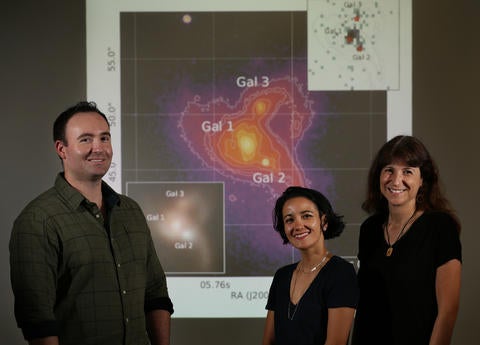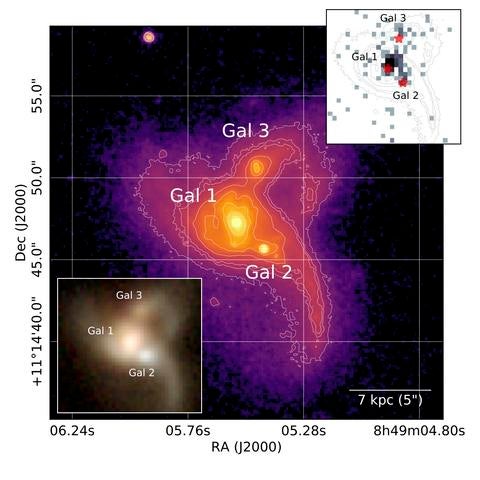Three giant black holes have been spotted within a titanic collision of three galaxies, according to data captured by several telescopes including NASA’s Chandra X-ray Observatory.
“Identifying the three active black holes, or active galactic nuclei, in this system was like putting together a puzzle,” said Gabriela Canalizo, a professor of physics and astronomy at the University of California, Riverside, and one of the senior authors of a new paper in The Astrophysical Journal describing these results. “We had to put together many pieces of evidence to form a final picture that convincingly showed this was a merger of three active galactic nuclei.”
Canalizo explained that triple merging active galactic nuclei, or AGN, are interesting because they provide a way for supermassive black holes to merge more easily: One of the black holes can take away some of the energy from the system, so that the other two can “sink” into each other.

“Gravitational waves have recently shown us that black hole mergers are relatively common, and triple black hole mergers may give us a least one pathway in which these mergers can happen,” she said.
“We were only looking for pairs of black holes at the time, and yet through our selection technique we stumbled upon this amazing system,” said Ryan Pfeifle of George Mason University in Fairfax, Virginia, the first author of a research paper. “This is the strongest evidence yet found for such a triple system of actively feeding supermassive black holes.”
The system is known as SDSS J084905.51+111447.2 (SDSS J0849+1114 for short) and is located 1 billion light years from Earth.
To uncover this rare black hole trifecta, researchers needed to combine data from telescopes both on the ground and in space. First, the Sloan Digital Sky Survey, or SDSS, an optical telescope that scans large swaths of the sky from New Mexico, imaged SDSS J0849+1114. With the help of citizen scientists across the globe as part of the Galaxy Zoo Project, it was then tagged as a system of colliding galaxies.
Then infrared imaging data from NASA’s WISE mission revealed that the system was glowing intensely in the infrared during a phase in the galaxy merger when more than one of the black holes is expected to be feeding rapidly. To follow up on these clues, astronomers then turned to the Chandra X-ray Observatory and spectroscopic observations at optical and infrared wavelengths with Large Binocular Telescope, or LBT, in Arizona.
The Chandra data revealed X-ray sources — a tell-tale sign of material being consumed by the black holes — at the bright centers of each galaxy in the merger, exactly where scientists expect supermassive black holes to reside. Chandra and NASA’s Nuclear Spectroscopic Telescope Array, or NuSTAR, also found evidence for large amounts of gas and dust around one of the black holes, typical for a merging black hole system.
Meanwhile, the optical light data from SDSS and LBT showed characteristic spectral signatures of material being consumed by the three supermassive black holes.

“Optical spectra contain a wealth of information about a galaxy,” said co-author Christina Manzano-King of UC Riverside. “They are commonly used to identify actively accreting supermassive black holes and can reflect the impact they have on the galaxies they inhabit.”
“Dual and triple black holes are exceedingly rare,” said co-author Shobita Satyapal, also of George Mason. “But such systems are actually a natural consequence of galaxy mergers, which we think is how galaxies grow and evolve.”
One reason it is difficult to find a triplet of supermassive black holes is that they are likely to be shrouded in gas and dust, blocking much of their light. The infrared images of WISE and the infrared spectra from LBT bypassed this issue, because infrared light pierces clouds of gas much more easily than optical light.
“Through the use of these major observatories, we have identified a unique way of selecting triple supermassive black holes. Each telescope gives us a different clue about what’s going on in these systems,” said Pfeifle. “We hope to extend our work to find more triples using the same technique.”
A triple black hole merger has a different set of dynamics than just a pair. Three black holes interacting should greatly reduce the amount of time it will take for a pair of the supermassive black holes to merge into a larger black hole. This may be a solution to the "final parsec problem," an ongoing theoretical conundrum where two supermassive black holes can approach to within a few light years of each other, but ultimately may never merge because they cannot get rid of their excess energy and angular momentum.
Computer simulations have shown that 16% of pairs of supermassive black holes in colliding galaxies will have interacted with a third supermassive black hole before they merge. Such mergers will produce gravitational waves that may be detectable with radio observations of pulsars, as well as future space observatories, such as the Laser Interferometer Space Antenna, which will detect black holes up to 1 million solar masses.
The paper describing these results appears in the latest issue of The Astrophysical Journal and a preprint is also available. NASA’s Marshall Space Flight Center manages the Chandra program. The Smithsonian Astrophysical Observatory’s Chandra X-ray Center controls science and flight operations from Cambridge, Massachusetts.
Q & A with Canalizo:

How did the collaboration with George Mason University come about?
Our collaborators from George Mason University have lots of experience in X-ray and infrared space-based observations, but they lack the expertise in optical and near-infrared ground-based observations that my group has.
When they came to UCR in January for a small workshop I organized, they presented this puzzle to us. Using optical and near-infrared tools to identify AGN is something I have worked on for decades, so it was easy for me to lay out a path to analyze the data and provide the extra evidence needed to close the case. Meanwhile, my graduate students, Remington Sexton and Christina Manzano-King, had developed very sophisticated modeling tools for their theses that were easily applicable to the problem at hand.
Barry Rothberg, our collaborator at the University of Arizona, provided LBT optical and near infrared observations of the triple merger that Christina and Remington were able to analyze. In a matter of hours, we had an answer: This was indeed a case of a triple AGN merging system. Of course, it took several more months of work to carefully assess all the uncertainties, and, in the end, we determined the result was robust.
Why is it important that these are AGN and not just dormant black holes?
A black hole is easiest to detect if it is accreting, that is, if it is an AGN. AGN also provide the only way to measure black hole masses in the nonlocal universe. So, while we do see many cases of three galaxies merging with each other besides this one, we have no way of knowing whether they have black holes that will also merge. Even if we assume that those other galaxies have black holes, we have no way of measuring their masses or any other characteristics. Discovering three AGN that are actually merging allows us to learn much about merging black holes.
Peter Edmonds and Megan Watzke of Chandra public affairs made significant contributions to this article.